check engine Alfa Romeo Giulietta 2013 Owner handbook (in English)
[x] Cancel search | Manufacturer: ALFA ROMEO, Model Year: 2013, Model line: Giulietta, Model: Alfa Romeo Giulietta 2013Pages: 292, PDF Size: 13.06 MB
Page 186 of 292
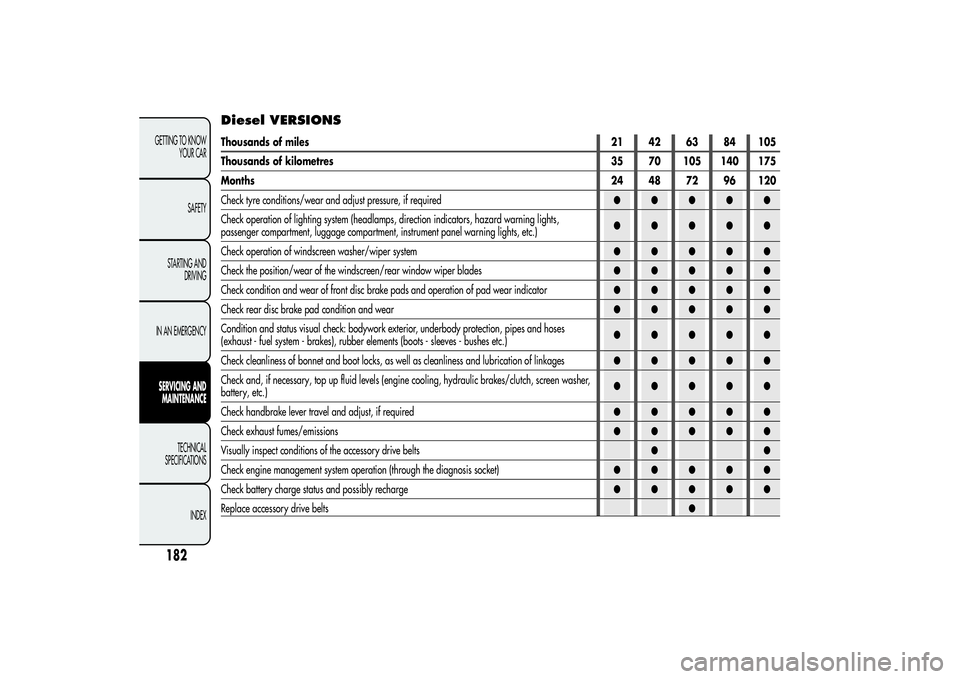
Diesel VERSIONSThousands of miles21 42 63 84 105
Thousands of kilometres 35 70 105 140 175
Months24 48 72 96 120
Check tyre conditions/wear and adjust pressure, if required●●●●●
Check operation of lighting system (headlamps, direction indicators, hazard warning lights,
passenger compartment, luggage compartment, instrument panel warning lights, etc.)●●●●●
Check operation of windscreen washer/wiper system●●●●●
Check the position/wear of the windscreen/rear window wiper blades●●●●●
Check condition and wear of front disc brake pads and operation of pad wear indicator●●●●●
Check rear disc brake pad condition and wear●●●●●
Condition and status visual check: bodywork exterior, underbody protection, pipes and hoses
(exhaust - fuel system - brakes), rubber elements (boots - sleeves - bushes etc.)●●●●●
Check cleanliness of bonnet and boot locks, as well as cleanliness and lubrication of linkages●●●●●
Check and, if necessary, top up fluid levels (engine cooling, hydraulic brakes/clutch, screen washer,
battery, etc.)●●●●●
Check handbrake lever travel and adjust, if required●●●●●
Check exhaust fumes/emissions●●●●●
Visually inspect conditions of the accessory drive belts●●
Check engine management system operation (through the diagnosis socket)●●●●●
Check battery charge status and possibly recharge●●●●●
Replace accessory drive belts●
182GETTING TO KNOW
YOUR CAR
SAFETY
STARTING AND
DRIVING
IN AN EMERGENCYSERVICING AND
MAINTENANCE
TECHNICAL
SPECIFICATIONS
INDEX
Page 188 of 292
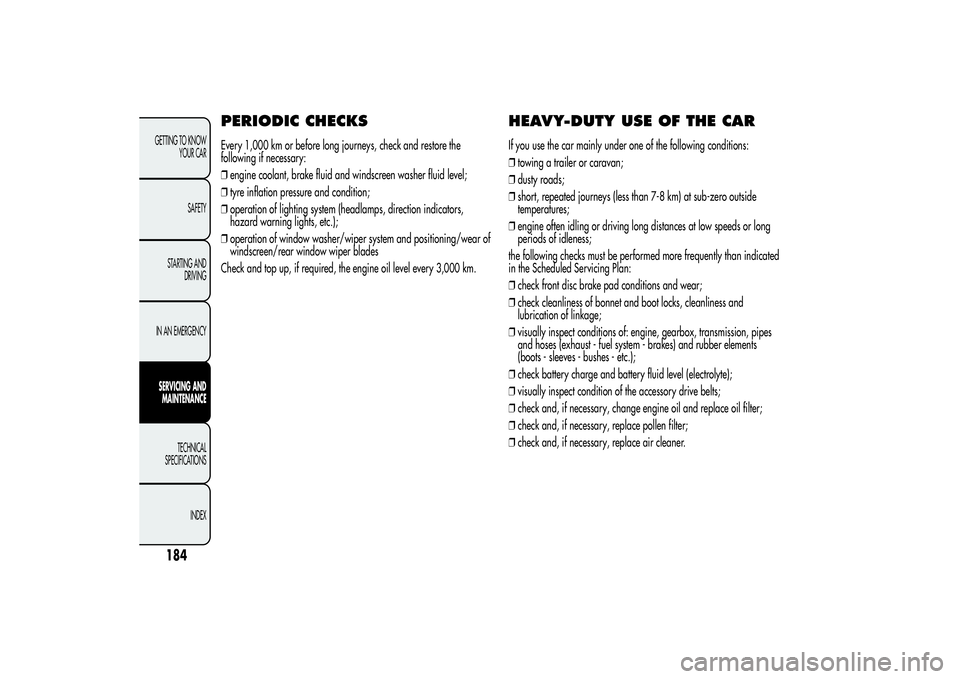
PERIODIC CHECKSEvery 1,000 km or before long journeys, check and restore the
following if necessary:
❒engine coolant, brake fluid and windscreen washer fluid level;
❒tyre inflation pressure and condition;
❒operation of lighting system (headlamps, direction indicators,
hazard warning lights, etc.);
❒operation of window washer/wiper system and positioning/wear of
windscreen/rear window wiper blades
Check and top up, if required, the engine oil level every 3,000 km.
HEAVY-DUTY USE OF THE CARIf you use the car mainly under one of the following conditions:
❒towing a trailer or caravan;
❒dusty roads;
❒short, repeated journeys (less than 7-8 km) at sub-zero outside
temperatures;
❒engine often idling or driving long distances at low speeds or long
periods of idleness;
the following checks must be performed more frequently than indicated
in the Scheduled Servicing Plan:
❒check front disc brake pad conditions and wear;
❒check cleanliness of bonnet and boot locks, cleanliness and
lubrication of linkage;
❒visually inspect conditions of: engine, gearbox, transmission, pipes
and hoses (exhaust - fuel system - brakes) and rubber elements
(boots - sleeves - bushes - etc.);
❒check battery charge and battery fluid level (electrolyte);
❒visually inspect condition of the accessory drive belts;
❒check and, if necessary, change engine oil and replace oil filter;
❒check and, if necessary, replace pollen filter;
❒check and, if necessary, replace air cleaner.
184GETTING TO KNOW
YOUR CAR
SAFETY
STARTING AND
DRIVING
IN AN EMERGENCYSERVICING AND
MAINTENANCE
TECHNICAL
SPECIFICATIONS
INDEX
Page 189 of 292
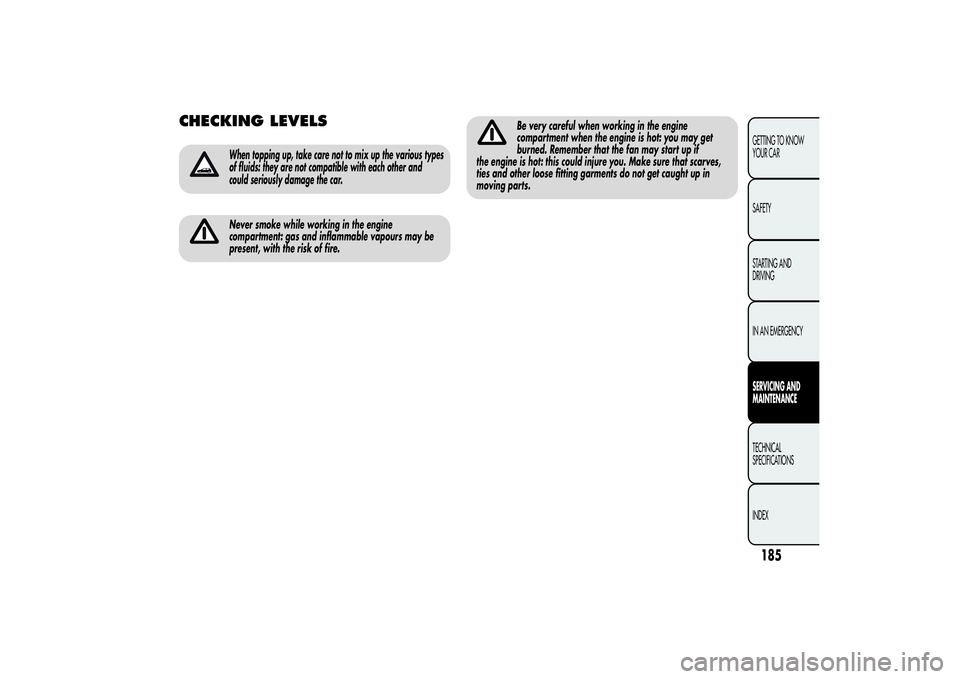
CHECKING LEVELS
When topping up, take care not to mix up the various types
of fluids: they are not compatible with each other and
could seriously damage the car.Never smoke while working in the engine
compartment: gas and inflammable vapours may be
present, with the risk of fire.
Be very careful when working in the engine
compartment when the engine is hot: you may get
burned. Remember that the fan may start up if
the engine is hot: this could injure you. Make sure that scarves,
ties and other loose fitting garments do not get caught up in
moving parts.
185GETTING TO KNOW
YOUR CAR
SAFETY
STARTING AND
DRIVING
IN AN EMERGENCYSERVICING AND
MAINTENANCETECHNICAL
SPECIFICATIONS
INDEX
Page 194 of 292
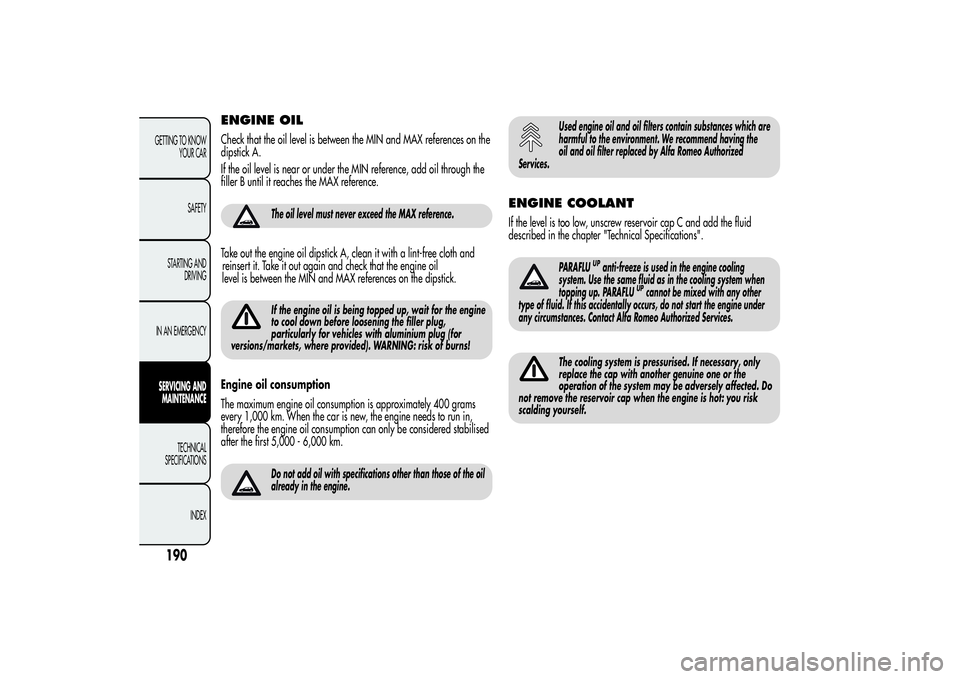
ENGINE OILCheck that the oil level is between the MIN and MAX references on the
dipstick A.
If the oil level is near or under the MIN reference, add oil through the
filler B until it reaches the MAX reference.
The oil level must never exceed the MAX reference.
Take out the engine oil dipstick A, clean it with a lint-free cloth and
reinsert it. Take it out again and check that the engine oil
level is between the MIN and MAX references on the dipstick.
If the engine oil is being topped up, wait for the engine
to cool down before loosening the filler plug,
particularly for vehicles with aluminium plug (for
versions/markets, where provided). WARNING: risk of burns!
Engine oil consumption
The maximum engine oil consumption is approximately 400 grams
every 1,000 km. When the car is new, the engine needs to run in,
therefore the engine oil consumption can only be considered stabilised
after the first 5,000 - 6,000 km.
Do not add oil with specifications other than those of the oil
already in the engine.
Used engine oil and oil filters contain substances which are
harmful to the environment. We recommend having the
oil and oil filter replaced by Alfa Romeo Authorized
Services.
ENGINE COOLANTIf the level is too low, unscrew reservoir cap C and add the fluid
described in the chapter "Technical Specifications".
PARAFLU
UPanti-freeze is used in the engine cooling
system. Use the same fluid as in the cooling system when
topping up. PARAFLU
UPcannot be mixed with any other
type of fluid. If this accidentally occurs, do not start the engine under
any circumstances. Contact Alfa Romeo Authorized Services.
The cooling system is pressurised. If necessary, only
replace the cap with another genuine one or the
operation of the system may be adversely affected. Do
not remove the reservoir cap when the engine is hot: you risk
scalding yourself.
190GETTING TO KNOW
YOUR CAR
SAFETY
STARTING AND
DRIVING
IN AN EMERGENCYSERVICING AND
MAINTENANCE
TECHNICAL
SPECIFICATIONS
INDEX
Page 195 of 292
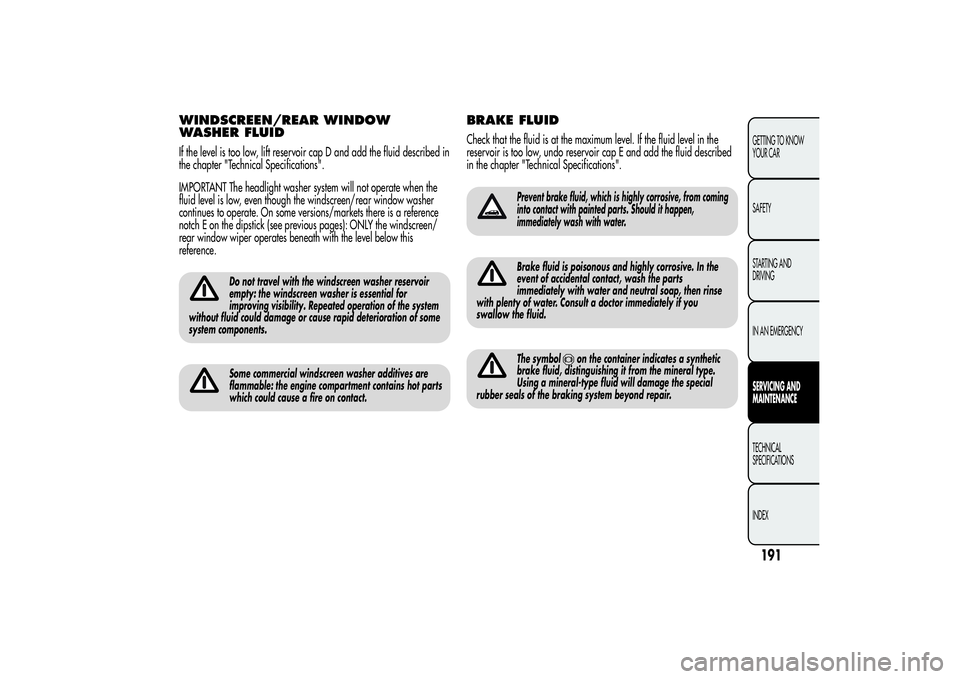
WINDSCREEN/REAR WINDOW
WASHER FLUIDIf the level is too low, lift reservoir cap D and add the fluid described in
the chapter "Technical Specifications".
IMPORTANT The headlight washer system will not operate when the
fluid level is low, even though the windscreen/rear window washer
continues to operate. On some versions/markets there is a reference
notch E on the dipstick (see previous pages): ONLY the windscreen/
rear window wiper operates beneath with the level below this
reference.
Do not travel with the windscreen washer reservoir
empty: the windscreen washer is essential for
improving visibility. Repeated operation of the system
without fluid could damage or cause rapid deterioration of some
system components.Some commercial windscreen washer additives are
flammable: the engine compartment contains hot parts
which could cause a fire on contact.
BRAKE FLUIDCheck that the fluid is at the maximum level. If the fluid level in the
reservoir is too low, undo reservoir cap E and add the fluid described
in the chapter "Technical Specifications".
Prevent brake fluid, which is highly corrosive, from coming
into contact with painted parts. Should it happen,
immediately wash with water.Brake fluid is poisonous and highly corrosive. In the
event of accidental contact, wash the parts
immediately with water and neutral soap, then rinse
with plenty of water. Consult a doctor immediately if you
swallow the fluid.The symbol
on the container indicates a synthetic
brake fluid, distinguishing it from the mineral type.
Using a mineral-type fluid will damage the special
rubber seals of the braking system beyond repair.
191GETTING TO KNOW
YOUR CAR
SAFETY
STARTING AND
DRIVING
IN AN EMERGENCYSERVICING AND
MAINTENANCETECHNICAL
SPECIFICATIONS
INDEX
Page 196 of 292
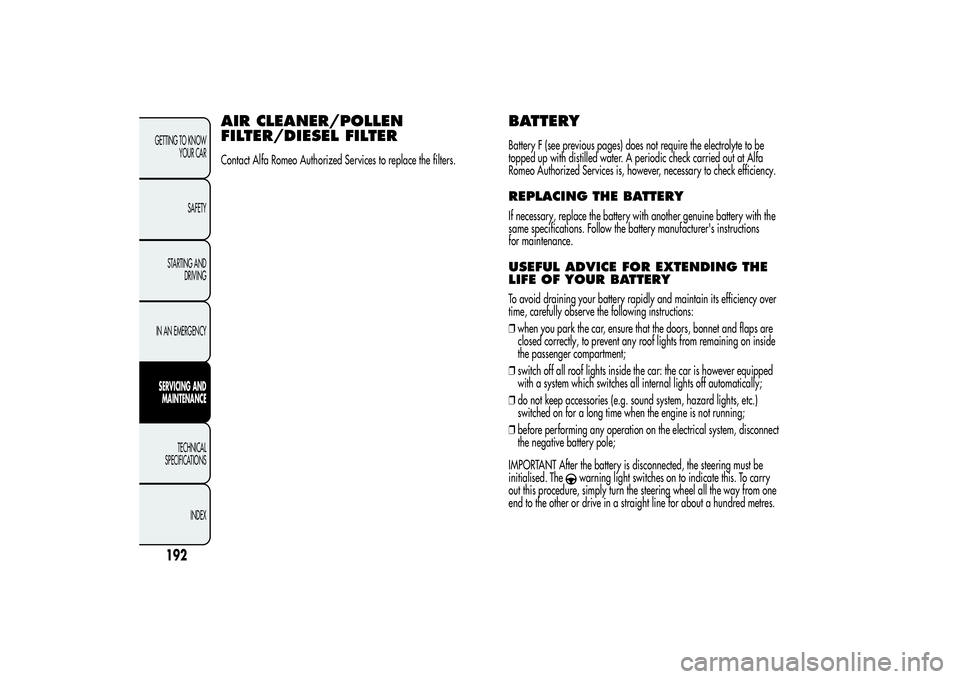
AIR CLEANER/POLLEN
FILTER/DIESEL FILTERContact Alfa Romeo Authorized Services to replace the filters.
BATTERYBattery F (see previous pages) does not require the electrolyte to be
topped up with distilled water. A periodic check carried out at Alfa
Romeo Authorized Services is, however, necessary to check efficiency.REPLACING THE BATTERYIf necessary, replace the battery with another genuine battery with the
same specifications. Follow the battery manufacturer's instructions
for maintenance.USEFUL ADVICE FOR EXTENDING THE
LIFE OF YOUR BATTERYTo avoid draining your battery rapidly and maintain its efficiency over
time, carefully observe the following instructions:
❒when you park the car, ensure that the doors, bonnet and flaps are
closed correctly, to prevent any roof lights from remaining on inside
the passenger compartment;
❒switch off all roof lights inside the car: the car is however equipped
with a system which switches all internal lights off automatically;
❒do not keep accessories (e.g. sound system, hazard lights, etc.)
switched on for a long time when the engine is not running;
❒before performing any operation on the electrical system, disconnect
the negative battery pole;
IMPORTANT After the battery is disconnected, the steering must be
initialised. The
warning light switches on to indicate this. To carry
out this procedure, simply turn the steering wheel all the way from one
end to the other or drive in a straight line for about a hundred metres.
192GETTING TO KNOW
YOUR CAR
SAFETY
STARTING AND
DRIVING
IN AN EMERGENCYSERVICING AND
MAINTENANCE
TECHNICAL
SPECIFICATIONS
INDEX
Page 204 of 292
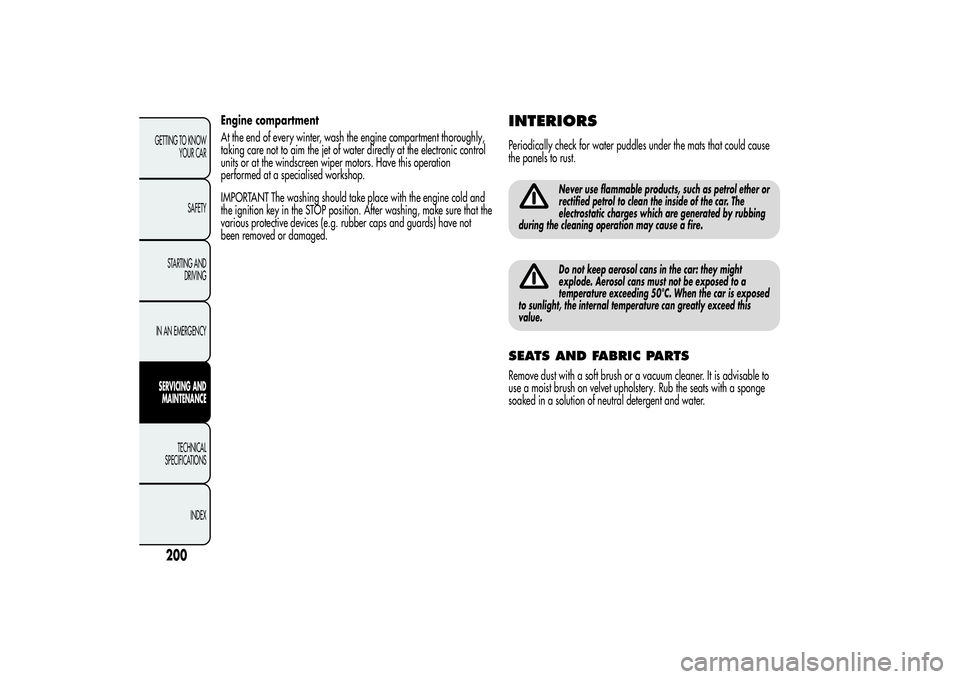
Engine compartment
At the end of every winter, wash the engine compartment thoroughly,
taking care not to aim the jet of water directly at the electronic control
units or at the windscreen wiper motors. Have this operation
performed at a specialised workshop.
IMPORTANT The washing should take place with the engine cold and
the ignition key in the STOP position. After washing, make sure that the
various protective devices (e.g. rubber caps and guards) have not
been removed or damaged.
INTERIORSPeriodically check for water puddles under the mats that could cause
the panels to rust.
Never use flammable products, such as petrol ether or
rectified petrol to clean the inside of the car. The
electrostatic charges which are generated by rubbing
during the cleaning operation may cause a fire.Do not keep aerosol cans in the car: they might
explode. Aerosol cans must not be exposed to a
temperature exceeding 50°C. When the car is exposed
to sunlight, the internal temperature can greatly exceed this
value.
SEATS AND FABRIC PARTSRemove dust with a soft brush or a vacuum cleaner. It is advisable to
use a moist brush on velvet upholstery. Rub the seats with a sponge
soaked in a solution of neutral detergent and water.
200GETTING TO KNOW
YOUR CAR
SAFETY
STARTING AND
DRIVING
IN AN EMERGENCYSERVICING AND
MAINTENANCE
TECHNICAL
SPECIFICATIONS
INDEX
Page 263 of 292

PHONE FUNCTION(telephone volume adjustment)
(only with Blue&Me™ system)
When a phone call is received, the audio passes to the car’s audio
system through the radio.
The telephone audio always arrives at a preset volume, but it is
possible to adjust it during a conversation using the left knobA
(fig. 1).
If, while using theBlue&Me™, the phone call volume is changed,
it is shown on the radio display, memorised and kept for all
following phone calls until the engine is switched off.
With the RADIO ON VOLUME function active, when the engine is
started again:
❒if the radio was switched off with aBlue&Me™ volume lower
than 12, theBlue&Me™ volume will be set to 12 automatically
for the next phone call;
❒if the radio was switched off with aBlue&Me™ volume higher
than 25, theBlue&Me™ volume will be set to 25 automatically
for the next phone call;
❒if the radio was switched off with aBlue&Me™ volume
between 12 and 25, theBlue&Me™ volume for the next
phone call will be that set previously by the user.
If, on the other hand, the RADIO ON VOLUME function is
deactivated, the radio keeps the last setting.
ANTI-THEFT PROTECTIONThe radio is equipped with an anti-theft protection system based on
the exchange of information between the radio and the electronic
control unit (Body Computer) on the car.
This system guarantees maximum safety and avoids the entry of
the secret code each time the radio power supply is disconnected.
If the check has a positive outcome, the radio will start to function,
whereas if the comparison codes are not the same or if the
electronic control unit (Body Computer) is replaced, the device will
ask the user to enter the secret code according to the procedure
described in the paragraph below.
Entering the secret code
When the radio is switched on, if the code is requested, the display
will show “Radio code” for about 2 seconds followed by four
dashes “----”.
The code is made up of four numbers from 1 to 6, each
corresponding to one of the dashes.
To enter the first digit of the code, press the corresponding button
of the pre-selected stations (from 1 to 6). Enter the other code
numbers in the same way.
If the four digits are not entered within 20 seconds, the display will
show “Enter code----”.Ifthisoccurs, it is not considered an
incorrect code entry.
After entering the fourth digit (within 20 seconds), the radio will
start to operate.
259SOUND-SYSTEM
Page 287 of 292
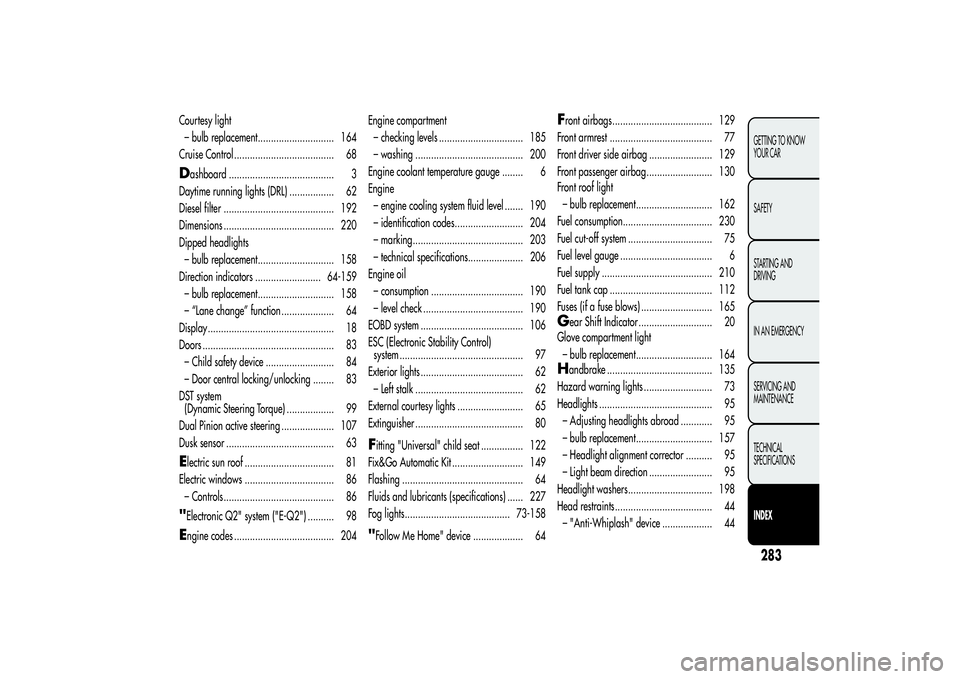
Courtesy light
– bulb replacement............................. 164
Cruise Control ...................................... 68Dashboard ........................................ 3
Daytime running lights (DRL) ................. 62
Diesel filter .......................................... 192
Dimensions .......................................... 220
Dipped headlights
– bulb replacement............................. 158
Direction indicators ......................... 64-159
– bulb replacement............................. 158
– “Lane change” function .................... 64
Display................................................ 18
Doors .................................................. 83
– Child safety device .......................... 84
– Door central locking/unlocking ........ 83
DST system
(Dynamic Steering Torque) .................. 99
Dual Pinion active steering .................... 107
Dusk sensor ......................................... 63Electric sun roof .................................. 81
Electric windows .................................. 86
– Controls .......................................... 86"Electronic Q2" system ("E-Q2") .......... 98Engine codes ...................................... 204Engine compartment
– checking levels ................................ 185
– washing ......................................... 200
Engine coolant temperature gauge ........ 6
Engine
– engine cooling system fluid level ....... 190
– identification codes.......................... 204
– marking.......................................... 203
– technical specifications..................... 206
Engine oil
– consumption ................................... 190
– level check ...................................... 190
EOBD system ....................................... 106
ESC (Electronic Stability Control)
system ............................................... 97
Exterior lights ....................................... 62
– Left stalk ......................................... 62
External courtesy lights ......................... 65
Extinguisher ......................................... 80
Fitting "Universal" child seat ................ 122
Fix&Go Automatic Kit ........................... 149
Flashing .............................................. 64
Fluids and lubricants (specifications) ...... 227
Fog lights........................................ 73-158"Follow Me Home" device ................... 64
Front airbags...................................... 129
Front armrest ....................................... 77
Front driver side airbag ........................ 129
Front passenger airbag ......................... 130
Front roof light
– bulb replacement............................. 162
Fuel consumption.................................. 230
Fuel cut-off system ................................ 75
Fuel level gauge ................................... 6
Fuel supply .......................................... 210
Fuel tank cap ....................................... 112
Fuses (if a fuse blows) ........................... 165G
ear Shift Indicator ............................ 20
Glove compartment light
– bulb replacement............................. 164
H
andbrake ........................................ 135
Hazard warning lights .......................... 73
Headlights ........................................... 95
– Adjusting headlights abroad ............ 95
– bulb replacement............................. 157
– Headlight alignment corrector .......... 95
– Light beam direction ........................ 95
Headlight washers................................ 198
Head restraints..................................... 44
– "Anti-Whiplash" device ................... 44
28GETTING TO KNOW
YOUR CAR
SAFETY
STARTING AND
DRIVING
IN AN EMERGENCY
SERVICING AND
MAINTENANCE
TECHNICAL
SPECIFICATIONSINDEX
3
Page 288 of 292
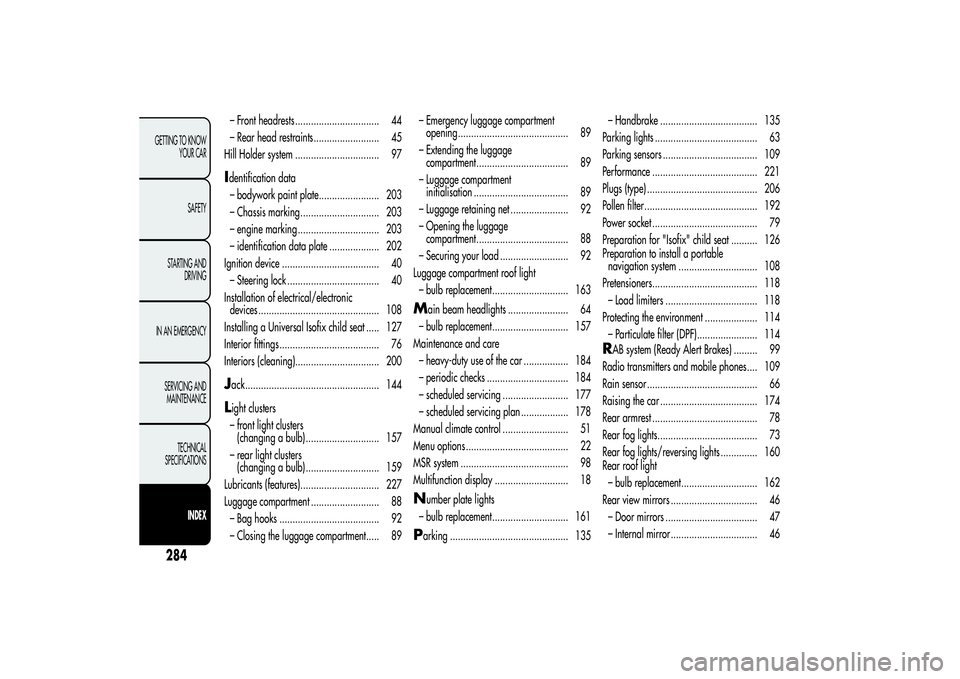
– Front headrests ................................ 44
– Rear head restraints......................... 45
Hill Holder system ................................ 97Identification data
– bodywork paint plate....................... 203
– Chassis marking .............................. 203
– engine marking ............................... 203
– identification data plate ................... 202
Ignition device ..................................... 40
– Steering lock ................................... 40
Installation of electrical/electronic
devices .............................................. 108
Installing a Universal Isofix child seat ..... 127
Interior fittings ...................................... 76
Interiors (cleaning)................................ 200Jack................................................... 144Light clusters
– front light clusters
(changing a bulb)............................ 157
– rear light clusters
(changing a bulb)............................ 159
Lubricants (features).............................. 227
Luggage compartment .......................... 88
– Bag hooks ...................................... 92
– Closing the luggage compartment..... 89– Emergency luggage compartment
opening .......................................... 89
– Extending the luggage
compartment................................... 89
– Luggage compartment
initialisation .................................... 89
– Luggage retaining net ...................... 92
– Opening the luggage
compartment................................... 88
– Securing your load .......................... 92
Luggage compartment roof light
– bulb replacement............................. 163
M
ain beam headlights ....................... 64
– bulb replacement............................. 157
Maintenance and care
– heavy-duty use of the car ................. 184
– periodic checks ............................... 184
– scheduled servicing ......................... 177
– scheduled servicing plan .................. 178
Manual climate control ......................... 51
Menu options ....................................... 22
MSR system ......................................... 98
Multifunction display ............................ 18
N
umber plate lights
– bulb replacement............................. 161
Parking ............................................. 135– Handbrake ..................................... 135
Parking lights ....................................... 63
Parking sensors .................................... 109
Performance ........................................ 221
Plugs (type) .......................................... 206
Pollen filter........................................... 192
Power socket ........................................ 79
Preparation for "Isofix" child seat .......... 126
Preparation to install a portable
navigation system .............................. 108
Pretensioners........................................ 118
– Load limiters ................................... 118
Protecting the environment .................... 114
– Particulate filter (DPF)....................... 114
RAB system (Ready Alert Brakes) ......... 99
Radio transmitters and mobile phones.... 109
Rain sensor .......................................... 66
Raising the car ..................................... 174
Rear armrest ........................................ 78
Rear fog lights...................................... 73
Rear fog lights/reversing lights .............. 160
Rear roof light
– bulb replacement............................. 162
Rear view mirrors ................................. 46
– Door mirrors ................................... 47
– Internal mirror ................................. 46
284GETTING TO KNOW
YOUR CAR
SAFETY
STARTING AND
DRIVING
IN AN EMERGENCY
SERVICING AND
MAINTENANCE
TECHNICAL
SPECIFICATIONS
INDEX